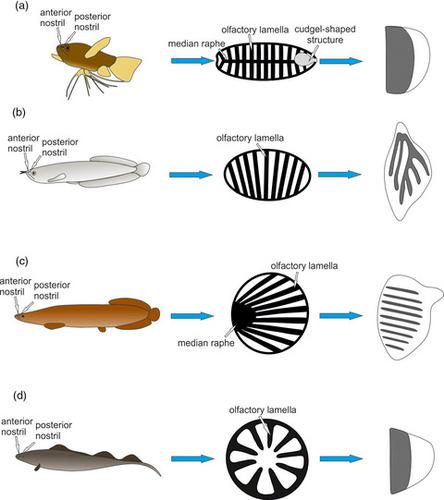Our official English website, www.x-mol.net, welcomes your
feedback! (Note: you will need to create a separate account there.)
Structural diversity of olfactory organs in Osteoglossiformes
Journal of Zoology ( IF 1.9 ) Pub Date : 2020-12-01 , DOI: 10.1111/jzo.12854 J. Dymek 1 , M. Kuciel 2 , K. Żuwała 1
Journal of Zoology ( IF 1.9 ) Pub Date : 2020-12-01 , DOI: 10.1111/jzo.12854 J. Dymek 1 , M. Kuciel 2 , K. Żuwała 1
Affiliation

|
Osteoglossomorpha, an ancient Teleostei group, exhibits many ancestral structural features. Herein, we describe the diversity in morphology of olfactory organs of air‐breathing Pantodon buchholzi, Arapaima gigas, and Gymnarchus niloticus in terms of adaptations to short ventures out of water and compare the results with the water‐breathing Osteoglossum bicirrhosum. We demonstrate the presence of olfactory rosettes within the olfactory chamber in all studied species and additionally a peculiar cudgel‐shaped structure in P. buchholzi. The typical olfactory rosette with centrally located elongate median raphe and two rows of olfactory lamellae was found only in P. buchholzi. In A. gigas, the olfactory lamellae arranged in semicircular manner were merged to small median raphe. Osteoglossum bicirrhosum and G. niloticus lacked median raphe, while the olfactory lamellae were ordered nearly parallel or circular, respectively. Olfactory epithelium lining the olfactory lamellae was unfolded only in P. buchholzi and G. niloticus. In contrast, in O. bicirrhosum and A. gigas convexities formed by nonsensory cells and concavities made by the sensory component were observed. Among the olfactory sensory neurons, ciliated and microvillus neurons were found in all studied species. Crypt‐like cells were noted only in P. buchholzi, whereas rod‐like cells were unique for A. gigas. The substantial morphological variation of the olfactory organ structure and ultrastructure in the studied osteoglossiforms may be explained by the early division of Osteoglossomorpha within Teleostei and long‐term, independent evolution within the families.
中文翻译:

骨形目动物嗅觉器官的结构多样性
骨骨morph,一个古老的Teleostei群体,具有许多祖先的结构特征。在这里,我们描述了呼吸空气的Pantodon buchholzi,Arapaima gigas和Gymnarchus niloticus的嗅觉器官在形态上的多样性,以适应从水上流出的短期风险,并将结果与呼吸水的Osteoglossum bicirrhosum进行了比较。我们证明了在所有研究的物种的嗅觉室内都存在嗅觉花环,此外在布氏假单胞菌中还存在奇特的棍状结构。仅在布氏疟原虫中发现典型的嗅觉莲座丛,其中央位于中间的细长中缝网眼和两排嗅觉片状细胞。在A. gigas中将半圆形排列的嗅觉薄片合并成小的正中缝。牛肝菌和尼罗罗非鱼缺乏正中线,而嗅叶分别有序排列成近似平行或圆形。衬在嗅薄片上的嗅上皮仅在布氏霍奇氏菌和尼罗罗非鱼中表现出来。相反,在O. bicirrhosum和A.牡蛎观察由非感觉细胞和由感觉成分制成凹部而形成的凸部。在嗅觉感觉神经元中,在所有研究物种中都发现纤毛和微绒毛神经元。仅在布氏假单胞菌中发现了隐窝样细胞,杆状细胞在长曲霉中是独特的。嗅骨器官的嗅觉器官结构和超微结构的形态学变化很大,可能是由于Teleostei内骨赘的早期分裂和家族内长期,独立的进化所致。
更新日期:2020-12-01
中文翻译:

骨形目动物嗅觉器官的结构多样性
骨骨morph,一个古老的Teleostei群体,具有许多祖先的结构特征。在这里,我们描述了呼吸空气的Pantodon buchholzi,Arapaima gigas和Gymnarchus niloticus的嗅觉器官在形态上的多样性,以适应从水上流出的短期风险,并将结果与呼吸水的Osteoglossum bicirrhosum进行了比较。我们证明了在所有研究的物种的嗅觉室内都存在嗅觉花环,此外在布氏假单胞菌中还存在奇特的棍状结构。仅在布氏疟原虫中发现典型的嗅觉莲座丛,其中央位于中间的细长中缝网眼和两排嗅觉片状细胞。在A. gigas中将半圆形排列的嗅觉薄片合并成小的正中缝。牛肝菌和尼罗罗非鱼缺乏正中线,而嗅叶分别有序排列成近似平行或圆形。衬在嗅薄片上的嗅上皮仅在布氏霍奇氏菌和尼罗罗非鱼中表现出来。相反,在O. bicirrhosum和A.牡蛎观察由非感觉细胞和由感觉成分制成凹部而形成的凸部。在嗅觉感觉神经元中,在所有研究物种中都发现纤毛和微绒毛神经元。仅在布氏假单胞菌中发现了隐窝样细胞,杆状细胞在长曲霉中是独特的。嗅骨器官的嗅觉器官结构和超微结构的形态学变化很大,可能是由于Teleostei内骨赘的早期分裂和家族内长期,独立的进化所致。









































 京公网安备 11010802027423号
京公网安备 11010802027423号